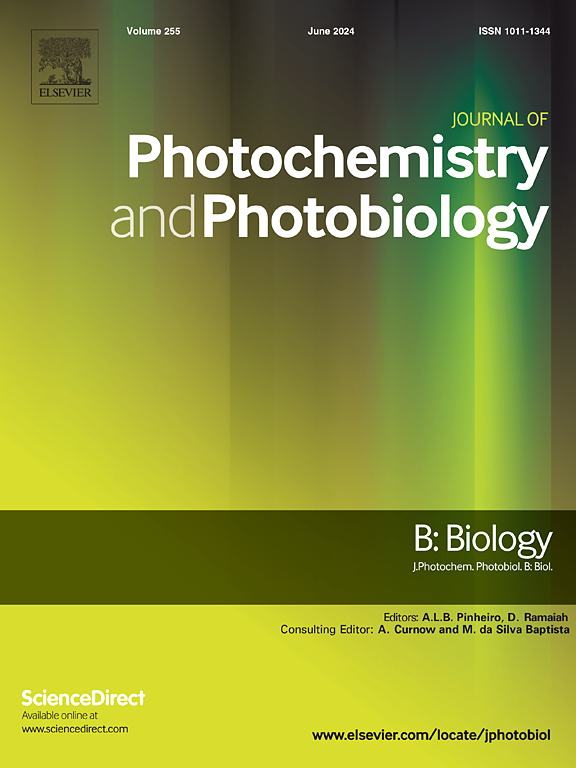Synergistic effects of oral milk ceramide-collagen peptides mixtures in preventing UV-induced inflammation and photoaging through TGF-β and NF-κB/MAPK signaling pathways in UV-exposed hairless mice
IF 3.7
2区 生物学
Q2 BIOCHEMISTRY & MOLECULAR BIOLOGY
Journal of photochemistry and photobiology. B, Biology
Pub Date : 2025-04-29
DOI:10.1016/j.jphotobiol.2025.113171
引用次数: 0
Abstract
This study investigates the synergistic effects of oral milk ceramide-collagen peptides in inhibiting UV-induced inflammation and preventing photoaging. The optimal ratio of milk ceramide to collagen peptides was determined in HaCaT cells, and the effects of oral supplementation of milk ceramide-collagen peptides were evaluated in UV-exposed hairless mice. HaCaT cells did not exhibit cytotoxicity when treated with milk ceramide and collagen peptides at concentrations up to 200 μg/mL. UVB exposure decreased cell viability, but treatment with the milk ceramide-collagen peptides mixtures (1:1, 1:3) prevented further viability loss and improved collagen peptides synthesis markers, including MMPs and TIMPs. The combination also enhanced moisture-related factors (AQP3, FLG) and reduced inflammatory cytokines (IL-6, IL-1β) and COX expression. In hairless mice, oral supplementation of milk ceramide-collagen peptides mixture (1:1 ratio) improved skin hydration, reduced erythema, TEWL, skin thickness, and wrinkle formation in a dose-dependent manner. The treatment also suppressed the expression of MMPs and TIMPs, promoting collagen peptides synthesis. Furthermore, the mixtures regulated NF-κB and MAPK signaling pathways, reducing inflammation and photoaging. These results suggest that the 1:1 milk ceramide-collagen peptides mixture effectively prevents UV-induced skin damage and photoaging by enhancing collagen peptides production and improving skin barrier function.
乳脂神经酰胺-胶原多肽复合物通过TGF-β和NF-κB/MAPK信号通路预防紫外线照射下无毛小鼠炎症和光老化的协同作用
本研究探讨了口服牛奶神经酰胺-胶原蛋白肽在抑制紫外线诱导的炎症和防止光老化中的协同作用。在HaCaT细胞中确定了乳神经酰胺与胶原肽的最佳比例,并在紫外线暴露的无毛小鼠中评价了口服乳神经酰胺-胶原肽的效果。当乳神经酰胺和胶原肽浓度达到200 μg/mL时,HaCaT细胞未表现出细胞毒性。UVB暴露降低了细胞活力,但用牛奶神经酰胺-胶原肽混合物(1:1,1:3)处理可防止细胞活力进一步丧失,并改善胶原肽合成标志物,包括MMPs和TIMPs。联合治疗还能增强水分相关因子(AQP3、FLG),降低炎症因子(IL-6、IL-1β)和COX的表达。在无毛小鼠中,口服补充牛奶神经酰胺-胶原肽混合物(1:1比例)可改善皮肤水合作用,减少红斑、TEWL、皮肤厚度和皱纹形成,并呈剂量依赖性。该处理还抑制了MMPs和TIMPs的表达,促进了胶原肽的合成。此外,混合物调节NF-κB和MAPK信号通路,减轻炎症和光老化。上述结果表明,乳神经酰胺-胶原肽1:1的混合物通过促进胶原肽的生成和改善皮肤屏障功能,有效地预防了紫外线引起的皮肤损伤和光老化。
本文章由计算机程序翻译,如有差异,请以英文原文为准。
求助全文
约1分钟内获得全文
求助全文
来源期刊
CiteScore
12.10
自引率
1.90%
发文量
161
审稿时长
37 days
期刊介绍:
The Journal of Photochemistry and Photobiology B: Biology provides a forum for the publication of papers relating to the various aspects of photobiology, as well as a means for communication in this multidisciplinary field.
The scope includes:
- Bioluminescence
- Chronobiology
- DNA repair
- Environmental photobiology
- Nanotechnology in photobiology
- Photocarcinogenesis
- Photochemistry of biomolecules
- Photodynamic therapy
- Photomedicine
- Photomorphogenesis
- Photomovement
- Photoreception
- Photosensitization
- Photosynthesis
- Phototechnology
- Spectroscopy of biological systems
- UV and visible radiation effects and vision.

 求助内容:
求助内容: 应助结果提醒方式:
应助结果提醒方式:


